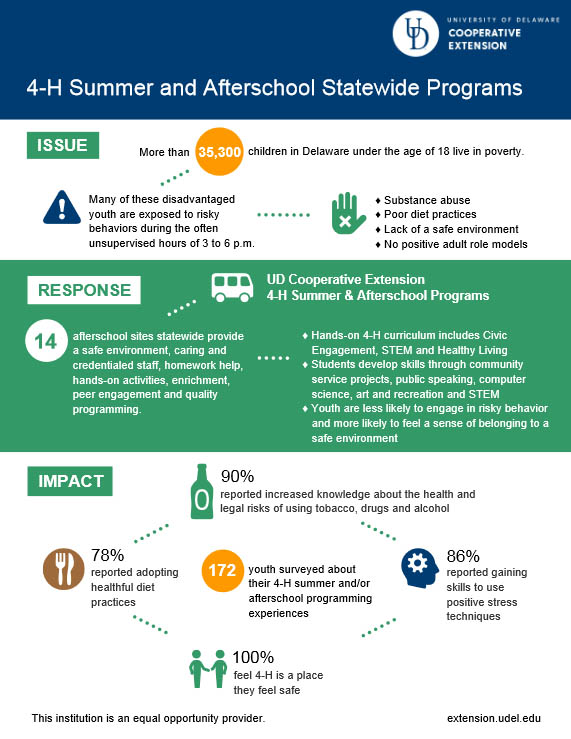
4-H Summer and Afterschool Activities (2018)

ISSUE
According to the 2018 Kids Count Fact book, more than 16.6 percent of children under the age of 18 in Delaware are living in poverty. Statewide, this alarming statistic equates to more than 35,300 youth. Many of these disadvantaged youth have early exposure to risky behaviors that include substance abuse, poor diet practices, and lack a safe environment to build relationships with other youth and adults. The Afterschool Alliance reports youth are more likely to engage in risky behaviors during the hours of 3 to 6 p.m. when they are often unsupervised. Research has also demonstrated that youth today are under increasing pressure and stressors and often lack the ability to cope further placing them at risk for engagement in risky behaviors. According to Compas et al. (2017), stress is the single most potent risk factor for mental health problems facing today’s youth. O’Neil et al. (2014) reported this lack of ability to cope and increased stress also impacts food choices. It is estimated one out of three kids is overweight, and despite this most are malnourished, likely due to these poor food choices. The Oregon Community Foundation (2016) found students often also lack a sense of belonging and the ability to develop effective relationships with positive adult role models. A sense of belonging was long ago identified by Maslow (1968) as a basic human need. When this basic need is not met, students are at higher risk to engage in these risky behaviors.
RESPONSE
UD Cooperative Extension 4-H Summer and Afterschool programs support youth and families statewide at 14 afterschool sites. These out-of-school-time programs provide a safe environment, caring and credentialed staff, homework help, hands-on activities, enrichment, peer engagement and quality programming. The hands-on 4-H curriculum includes Civic Engagement, STEM and Healthy Living. 4-H provides opportunities for students to develop skills through community service projects like community gardens, as well as skills in public speaking, computer science, art, recreation, STEM and more. By attending summer and afterschool programming, youth are less likely to engage in risky behaviors and more likely to feel a sense of belonging in a safe environment.
IMPACT
After participating in 4-H summer and/or afterschool programming statewide in 2018, youth were surveyed about their experiences and 172 responses were collected. These responses indicated:
- 90 percent report increased knowledge about the health and legal risks of using tobacco, drugs and alcohol;
- 85 percent report gaining skills and planning to resist negative behaviors;
- 86 percent report gaining skills to use positive stress techniques
- 75 percent report adopting positive stress techniques and coping skills they can use when they are frustrated or angry;
- 84 percent report gaining skills to use to follow healthy diet practices;
- 78 percent report adopting healthy diet practices;
- 100 percent feel 4-H is a place they feel safe;
- 100 percent feel 4-H is a place they feel like they belong; and
- 88 percent strongly agree 4-H adults care about them.
